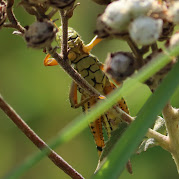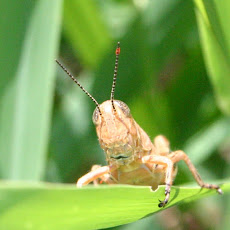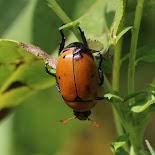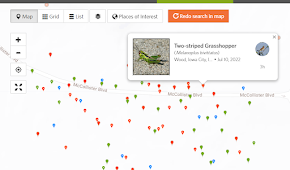I adore grasshoppers, and I love this time of year when practically every step in the grass sends dozens, if not hundreds, of grasshoppers launching themselves into the air like oil popping from a skillet, and landing with the rippling sound of soft ticks in the brush. The comical dance as they cling to a blade of grass and shift around it to quickly orient themselves and hide with just their feet and legs visible, sticking out from behind the leafy shield.
I love how baby grasshoppers are just tiny, big-headed versions of the adults, with itty bitty wing buds (no awkward wormy larval stage for these incomplete metamorphosizers!). Their complex chewing mouthparts with paired, segmented palpi like movable whiskers under their chin; the modest short antennae; the stout, shield-like pronotum behind the head; the cleverly articulated segments of their legs with the small cushiony pads comprising their feet (or tarsi); those oversized, inscrutable compound eyes.
 |
| A spiracle on the thorax circled in blue(other spiracles are found alongside the length of the abdomen). |
Their respiration! They breathe directly through holes in their sides called spiracles, and the air is distributed internally via tubes called tracheae--none of this inefficient breathing and eating through the same orifices, or mingling nutrient and gaseous circulation in the same system, like certain mammals.
 |
| "I just stumbled upon this carcass and couldn't resist the free protein, I swear!" |
I've always been partial to herbivores, and try to overlook the occasional incidents of cannibalism and fondly eye the holey, chewed leaves in my garden as evidence that it is a home and refuge for grasshoppers, caterpillars, and other small neighbors. The piggy-back style mating, with a much-smaller male clinging to the back of the larger female, followed by the female tidily stowing her eggs in the ground, often via a crack in the pavement.
I've found it difficult to reliably attach definite names to my grasshopper friends; though they don't usually require minute examination of their genitalia to determine species like some other insects, there are a wide variety of grasshoppers with varying colors even within the species, and small characteristics that can be seen without microscopic examination--but are not always easily visible from a candid photo snapped in situ.
 |
| Showing off the spur. |
The subfamily of Band-winged Grasshoppers, too, have distinctive features in the coloration and patterns of their wings--if you have the luxury of spreading them out and examining them. Try as I might to catch one in flight, the best I've managed is a blur of dark wings with pale edges (save the one memorable Carolina Grasshopper caught mid-spring in his alluring courtship display).
Now Slant-faced Grasshoppers--there's something I can work with! I think....
Sources/Additional Resources and Reading:
- Field Guide to Grasshoppers, Katydids, and Crickets of the United States
- How Does a Grasshopper Breathe? (Explained)
- Grasshoppers of Wyoming and the West
- The Ethical Grasshopper Musings on the fable of the Ants and the Grasshopper

















